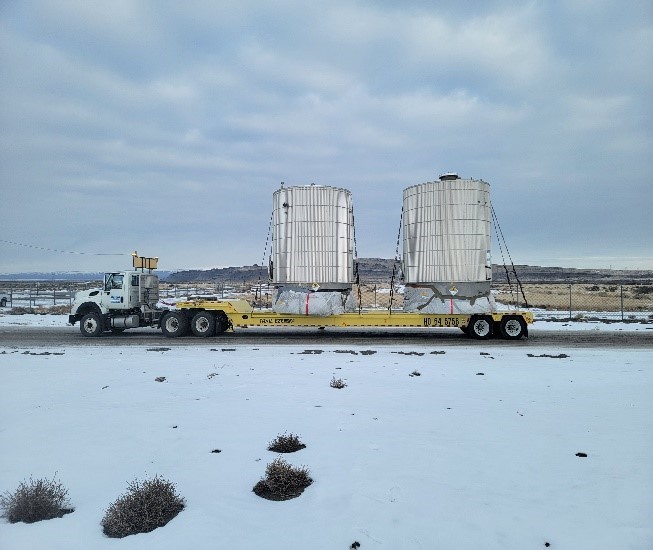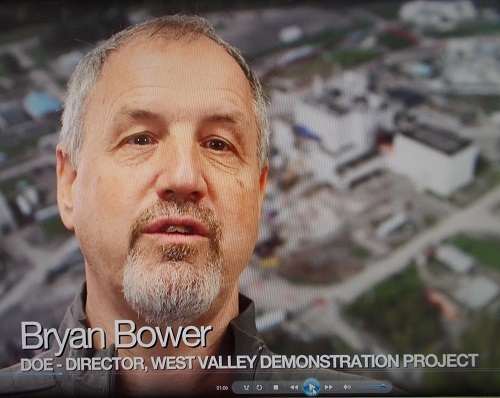 Hanford Mission Integration Solutions transports two empty tanks weighing more than five tons each from outside the Hanford Site’s Effluent Treatment Facility to an onsite landfill, making room for wastewater treatment work by EM Office of River Protection contractor Washington River Protection Solutions.
RICHLAND, Wash. – EM Richland Operations Office contractor Hanford Mission Integration Solutions (HMIS) recently removed two large tanks near the Effluent Treatment Facility (ETF) on the Hanford Site to make way for future wastewater treatment at the ETF.
HMIS provides Hanford Site services, including many transportation services. Its motor carrier services team worked with EM Office of River Protection contractor Washington River Protection Solutions (WRPS) to remove the excess tanks, each of which weighs more than five tons and stands nearly two stories high.
“This is another example of our One Hanford team working together to complete a risk-reduction project safely,” said Brian Harkins, EM assistant manager for mission support. “Each step, large or small, helps pave the path to tank-waste treatment on the Hanford Site.”
 Electrical lineworkers with Hanford Mission Integration Solutions carefully lift overhead power lines to allow a trailer hauling empty tanks to Hanford’s landfill to pass.
The tanks once held contaminated wastewater from Hanford Site operations for treatment at the adjacent ETF. WRPS is upgrading and expanding the ETF to improve capacity and treatment capability in support of the Direct-Feed Low-Activity Waste Program, and the tanks were no longer needed. The work required months of planning, covering all aspects of disconnecting, removing and disposing of the tanks.
Once loaded on a trailer, the tanks extended higher than overhead power lines at some locations on the site. So HMIS electrical utilities staff planned a transport route minimizing the number of utility lines that would need to be raised for the tanks and trailer to pass.
“To some, raising power lines may look like a simple task, but in reality, it is hazardous work that requires careful teamwork,” said Rick Boarder, HMIS electrical utilities director.
HMIS completed the seven-mile drive from the ETF to Hanford’s onsite landfill and disposed of the tanks.
-Contributor: Robin Wojtanik
 EM's West Valley Demonstration Project has released a new video in which experts at the site reflect on the Main Plant Process Building demolition and praise employees for their work on the project.
WEST VALLEY, N.Y. – Watch a new video featuring subject matter experts from EM and cleanup contractor CH2M HILL BWXT West Valley (CHBWV) discussing the ongoing demolition of the Main Plant Process Building at the West Valley Demonstration Project.
The Main Plant is the last major facility to be removed from the site and represents more than two decades of deactivation and decommissioning work. Witnessing this significant milestone that will forever change the landscape of the site is especially meaningful to longtime West Valley employees.
“The purpose of this video is to thank every employee here, as well as those who worked here in the past,” EM West Valley Director Bryan Bower said. “Individuals with diverse backgrounds and education used their collective experience, expertise and knowledge on how to safely deactivate and take down the Main Plant. That was all done here by an incredible workforce.”
 |
|
"This was something that the people here at West Valley did. Individual engineers and workers figured out the challenges on how we could deactivate the Main Plant, and then demolish the Main Plant. It was all done here. An incredible workforce." |
"I couldn't be happier. What's been accomplished here by this workforce, I'd put up against anyone. It's been going for two decades, really, preparing for this moment." |
|
 |
The subject matter experts appearing in the video have more than 200 years of combined experience in nuclear decommissioning and environmental cleanup. They provide technical support and oversight to ensure work is performed in a manner protective of human health and the surrounding environment.
“On September 21, 2022, we began the controlled deconstruction of the Main Plant, and our workforce, our awesome workforce, got us here,” said John Rendall, president of CHBWV. “What’s been accomplished here, by this workforce, is to be commended. Everything that’s happened since the signing of the West Valley Demonstration Project Act has led to this day, and our employees made it happen.”
EM’s planned approach to the Main Plant demolition incorporates best practices and lessons learned from West Valley and the broader EM complex. The approach includes a deliberately planned and sequenced demolition, implementation of robust work controls and use of specialized tools and techniques to safely deconstruct the building.
Demolition of the Main Plant is expected to take approximately 30 months to complete.
Watch the video here.
-Contributor: Joseph Pillittere
|